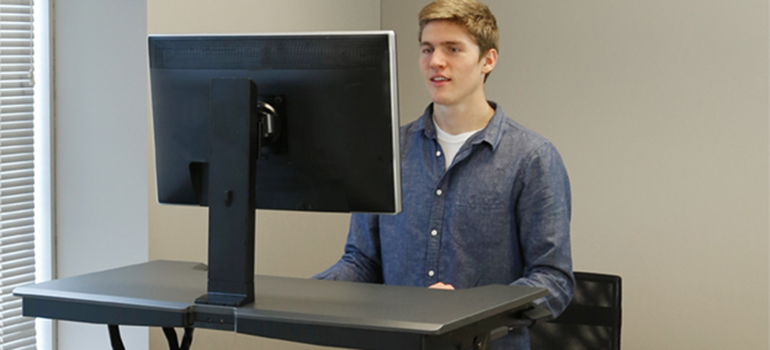
MoveMore Blog
The latest in workplace wellness

Study Confirms that Standing Too Long Causes Discomfort
You may have heard about an Australian study that’s garnered a lot of media attention recently. Reporters have made much of the researcher’s conclusions that standing desks can cause discomfort like back pain if people stand too long. As designers of some of the very first sit-stand workstations in the global market, we welcome empirical evidence that supports our belief that standing for long periods of time compromises musculoskeletal, metabolic and cognitive health.
The study
Data gathered by investigators at Curtin University was used to assess how prolonged standing may impact the health and productivity of office workers. 20 people were asked to stand for two hours in a lab setting while working at a computer—not your typical office setting by any means. The ergonomic community has known for many years that prolonged sitting and standing can be tiring, painful and distracting both in the short and long term. That fact served as the foundation for the invention of sit-stand desk and fuels our mission to help people and businesses create active workstyles, where the importance of good working postures, both sitting and standing, plays an important central role.
This study can serve as a reminder to all of us that we have a choice in creating a comfortable and supportive working environment. A standing desk environment can be rectified instantly with a tall stool or tall chair without compromising worker health or productivity. We hope this research will help illuminate the trouble spots in any business where workers are not able to choose a comfortable posture at will. Any posture should be adjusted routinely to reduce stress, body fatigue and other factors associated with a stagnant position for lengthy periods of time
Working up to the Sit-Stand Switch™
The goal of a sit-stand desk is to promote timely posture changes throughout the day. By alternating between sitting and standing every 30 minutes—the Sit-Stand Switch—employees can work comfortably at their desks without sacrificing productivity. Anyone adopting the Sit-Stand Switch should start with short intervals of standing (10 minutes per hour the first week and 20 minutes the second week) until they develop the stamina to stand for 30 minutes at a time. A gradual transition will help ensure that the negative symptoms experienced by participants in the Curtain University standing trial won’t happen to you!
The important thing is to get informed. To learn more about the research on sit-stand environments, visit research.ergotron.com or research.stand.pixels-360.com. There is ample evidence that using sit-stand desks reduces sedentary time and allows for the healthy movement necessary for comfortable computing. Also consider exploring some other sources on the topic:
- Standing for Workplace Wellness
- Why Movement Matters
- Anatomy of A Sit-Stand Company
- “Back on Track” infographic based on Stanford University research
So while this new study may seem to go against what is being advocated around the mission to reduce sedentary behavior, investigators of the study are helping the cause by documenting bio-mechanical and cognitive effects of prolonged standing.
Relevant Posts
Stay in the know
Sign up and get the latest and greatest content from JustStand's MoveMore blog.